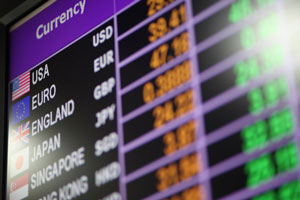A Stronger Dollar and the Profitability of U.S. Firms

When the U.S. dollar appreciates—as it did from the second quarter of 2014 to the first quarter of 2016—how does that affect the profitability of U.S. firms that rely heavily on foreign sales? A recent Economic Synopses essay suggests that such an appreciation lowered the market value of these firms, but only in the short run.
To estimate the impact of the recent appreciation of the dollar on firms’ profitability, Senior Economist YiLi Chien and Research Associate Paul Morris calculated the difference in stock market returns between firms with a large share of foreign sales (representing at least 50 percent of total sales) and firms with a low share of foreign sales (representing less than 50 percent of total sales).1
Impact on Profitability
Looking at the period from July 2014 to September 2016, the authors found that firms with a large share of foreign sales initially had relatively poor returns compared with firms with a low share of foreign sales. In particular, the cumulative return for the former group was more than 6 percentage points lower than the cumulative return for the latter group in the first seven months. The dollar appreciated more than 10 percent over that time.
The authors noted that the effect on profitability was reversed over the second half of the sample period even though the dollar appreciated another 10 percent. In fact, the cumulative return for firms with high foreign sales surpassed that of firms with low foreign sales in August 2016.
They wrote: “This result shows that the strong dollar eroded the market value of firms in the short run but not in the long run. In short, the strong dollar has not permanently damaged the profitability of firms with a significant amount of foreign sales.”
Possible Explanation
Chien and Morris noted that firms with high foreign sales are larger and tend to be multinational, and that they are likely able to adjust production and sales between the U.S. and foreign countries.
“The adjustment could be costly and slow and, hence, not feasible in the short term. In the long term, firms could shift production and possibly focus more on the domestic market to reduce the impact on profits caused by the dollar’s appreciation,” they wrote.
This could help explain why the sharp appreciation of the dollar from mid-2014 to early 2016 lowered the value of firms with high foreign sales only in the short run.
The authors concluded: “This empirical result indicates that, in the long run, U.S. firms can adjust quite well in response to a large and sharp exchange rate fluctuation.”
Notes and References
1 The authors used Compustat data on publicly traded U.S. firms.
Additional Resources
- Economic Synopses: Does a Stronger Dollar Erode the Profitability of U.S. Firms?
- On the Economy: Do Institutional Investors Chase Returns?
- On the Economy: Does a Strong Dollar Slow the Growth Rate of GDP?
Citation
ldquoA Stronger Dollar and the Profitability of U.S. Firms,rdquo St. Louis Fed On the Economy, Feb. 28, 2017.
This blog offers commentary, analysis and data from our economists and experts. Views expressed are not necessarily those of the St. Louis Fed or Federal Reserve System.
Email Us
All other blog-related questions

